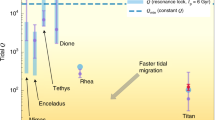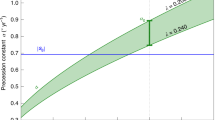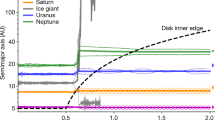Abstract
Mercury is locked into a 3/2 spin-orbit resonance where it rotates three times on its axis for every two orbits around the sun1,2,3. The stability of this equilibrium state is well established4,5,6, but our understanding of how this state initially arose remains unsatisfactory. Unless one uses an unrealistic tidal model with constant torques (which cannot account for the observed damping of the libration of the planet) the computed probability of capture into 3/2 resonance is very low (about 7 per cent)5. This led to the proposal that core–mantle friction may have increased the capture probability, but such a process requires very specific values of the core viscosity7,8. Here we show that the chaotic evolution of Mercury's orbit can drive its eccentricity beyond 0.325 during the planet's history, which very efficiently leads to its capture into the 3/2 resonance. In our numerical integrations of 1,000 orbits of Mercury over 4 Gyr, capture into the 3/2 spin-orbit resonant state was the most probable final outcome of the planet's evolution, occurring 55.4 per cent of the time.
This is a preview of subscription content, access via your institution
Access options
Subscribe to this journal
Receive 51 print issues and online access
$199.00 per year
only $3.90 per issue
Buy this article
- Purchase on Springer Link
- Instant access to full article PDF
Prices may be subject to local taxes which are calculated during checkout


Similar content being viewed by others
References
Pettengill, G. H. & Dyce, R. B. A radar determination of the rotation of the planet Mercury. Nature 206, 1240 (1965)
McGovern, W. E., Gross, S. H. & Rasool, S. I. Rotation period of the planet Mercury. Nature 208, 375 (1965)
Colombo, G. Rotation period of the planet Mercury. Nature 208, 575 (1965)
Colombo, G. & Shapiro, I. I. The rotation of the planet Mercury. Astrophys. J. 145, 296–307 (1966)
Goldreich, P. & Peale, S. J. Spin orbit coupling in the Solar System. Astron. J. 71, 425–438 (1966)
Counselman, C. C. & Shapiro, I. I. Spin-orbit resonance of Mercury. Symp. Math. 3, 121–169 (1970)
Goldreich, P. & Peale, S. J. Spin-orbit coupling in the solar system 2. The resonant rotation of Venus. Astron. J. 72, 662–668 (1967)
Peale, S. J. & Boss, A. P. A spin-orbit constraint on the viscosity of a Mercurian liquid core. J. Geophys. Res. 82, 743–749 (1977)
Anderson, J. D., Colombo, G., Espsitio, P. B., Lau, E. L. & Trager, G. B. The mass, gravity field, and ephemeris of Mercury. Icarus 71, 337–349 (1987)
Brouwer, D. & Van Woerkom, A. J. J. The secular variations of the orbital elements of the principal planets. Astron. Pap. Am. Ephem. XIII, part II, 81–107 (1950)
Bretagnon, P. Termes à longue périodes dans le système solaire. Astron. Astrophys. 30, 141–154 (1974)
Laskar, J. The chaotic motion of the solar system. Icarus 88, 266–291 (1990)
Laskar, J. Large-scale chaos in the Solar System. Astron. Astrophys. 287, L9–L12 (1994)
Laskar, J. et al. Long term evolution and chaotic diffusion of the insolation quantities of Mars. Icarus (in the press)
Spohn, T., Sohl, F., Wieczerkowski, K. & Conzelmann, V. The interior structure of Mercury: what we know, what we expect from BepiColombo. Planet. Space Sci. 49, 1561–1570 (2001)
Hansen, P. A. Entwickelung der products einer potenz des radius vectors mit dem sinus oder cosinus eines vielfachen der wahren anomalie in reihen. Abhandl. K. S. Ges. Wissensch. IV, 182–281 (1855)
Murray, C. D. & Dermott, S. F. Solar System Dynamics (Cambridge Univ. Press, Cambridge, 1999)
Correia, A. C. M. & Laskar, J. Néron de Surgy, O. Long term evolution of the spin of Venus. I. Theory. Icarus 163, 1–23 (2003)
Munk, W. H. & MacDonald, G. J. F. The Rotation of the Earth; A Geophysical Discussion (Cambridge Univ. Press, Cambridge, 1960)
Kaula, W. Tidal dissipation by solid friction and the resulting orbital evolution. J. Geophys. Res. 2, 661–685 (1964)
Yoder, C. F. Astrometric and geodetic properties of Earth and the Solar System. Glob. Earth Physics: A Handbook of Physical Constants 1–31 (American Geophysical Union, Washington DC, 1995)
Acknowledgements
This work was supported by PNP-CNRS, Paris Observatory CS, and Fundação para a Ciência e a Technologia, POCTI/FNU, Portugal. The numerical computations were made at IDRIS-CNRS, and Paris Observatory. Authors are listed in alphabetic order.
Author information
Authors and Affiliations
Corresponding author
Ethics declarations
Competing interests
The authors declare that they have no competing financial interests.
Rights and permissions
About this article
Cite this article
Correia, A., Laskar, J. Mercury's capture into the 3/2 spin-orbit resonance as a result of its chaotic dynamics. Nature 429, 848–850 (2004). https://doi.org/10.1038/nature02609
Received:
Accepted:
Issue Date:
DOI: https://doi.org/10.1038/nature02609
This article is cited by
-
Accurate Computations up to Breakdown of Quasi-Periodic Attractors in the Dissipative Spin–Orbit Problem
Journal of Nonlinear Science (2024)
-
Alien suns reversing in exoplanet skies
Scientific Reports (2022)
-
Efficient and Accurate KAM Tori Construction for the Dissipative Spin–Orbit Problem Using a Map Reduction
Journal of Nonlinear Science (2022)
-
An analytical model for tidal evolution in co-orbital systems. I. Application to exoplanets
Celestial Mechanics and Dynamical Astronomy (2021)
-
Geodesy, Geophysics and Fundamental Physics Investigations of the BepiColombo Mission
Space Science Reviews (2021)
Comments
By submitting a comment you agree to abide by our Terms and Community Guidelines. If you find something abusive or that does not comply with our terms or guidelines please flag it as inappropriate.



